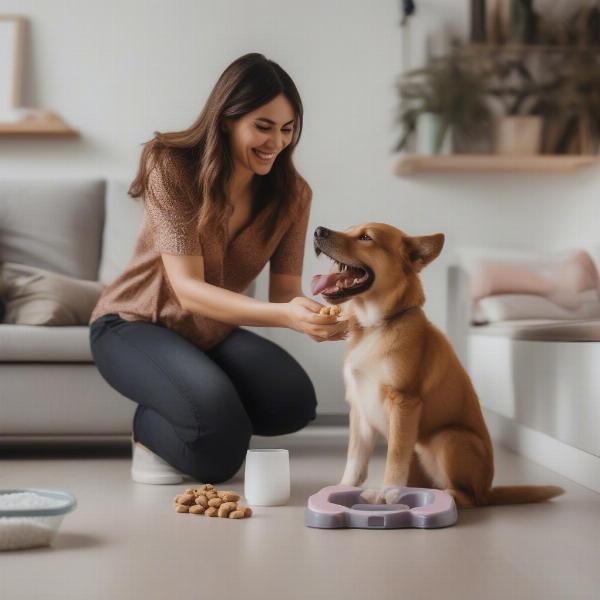Dog urine, with its potent ammonia smell, can be a real challenge for pet owners. Whether you’re dealing with accidents from a puppy in training, marking behaviors from an adult dog, or lingering odors in your home, a dog urine neutraliser is an essential tool. This guide explores everything you need to know about choosing and using the right neutraliser for your needs, ensuring a fresh and clean environment for both you and your furry friend.
Understanding the Need for a Dog Urine Neutraliser
Why is simply cleaning up the urine not enough? Regular cleaning products may remove the visible stain, but they often fail to eliminate the uric acid crystals that cause the persistent odor. These microscopic crystals are invisible to the naked eye but can linger in carpets, upholstery, and even concrete, attracting your dog back to the same spot to re-offend. A dog urine neutraliser works by breaking down these uric acid crystals, eliminating the odor at its source and discouraging repeat accidents.
Choosing the Right Dog Urine Neutraliser
With a wide array of products available, selecting the right neutraliser can feel overwhelming. Consider these factors:
- Enzymatic vs. Non-Enzymatic: Enzymatic neutralisers contain beneficial bacteria that break down uric acid. They are generally more effective at eliminating odors completely. Non-enzymatic neutralisers often mask the smell with fragrances but don’t address the underlying issue.
- Pet-Safe Formula: Ensure the product is safe for your pets and family. Look for non-toxic and biodegradable options.
- Surface Compatibility: Different neutralisers are formulated for various surfaces. Choose one suitable for carpets, upholstery, hardwood floors, or concrete, as needed.
- Scent: Some neutralisers have added fragrances, while others are odorless. Consider your preference and any potential sensitivities your pet might have.
How to Use a Dog Urine Neutraliser Effectively
Follow these steps for optimal results:
- Clean the Area: Blot up as much urine as possible with paper towels or a clean cloth.
- Apply the Neutraliser: Follow the product instructions carefully. Saturate the affected area and allow it to dwell for the recommended time.
- Allow to Dry: Air dry the area thoroughly. Avoid using heat, as it can deactivate the enzymes in enzymatic cleaners.
- Repeat if Necessary: For stubborn odors, you may need to repeat the process.
Preventing Future Accidents
While a dog urine neutraliser is a valuable tool, addressing the underlying cause of the accidents is crucial.
- House Training: Consistent potty breaks and positive reinforcement are key to successful house training.
- Medical Issues: Frequent urination can be a sign of a medical problem. Consult your veterinarian if you notice any changes in your dog’s urination habits.
- Behavioral Issues: Marking behavior can be addressed through training and behavior modification techniques.
 Dog being house trained
Dog being house trained
Conclusion
Dealing with dog urine accidents can be frustrating, but with the right tools and strategies, you can maintain a clean and odor-free home. A dog urine neutraliser is an essential tool for eliminating the source of the problem, the uric acid crystals. By choosing the right product and using it effectively, you can create a comfortable environment for both you and your beloved pet. Remember to address the underlying cause of the accidents to prevent future occurrences.
FAQ
- What is the best dog urine neutraliser? The best neutraliser depends on your specific needs and the type of surface you’re treating. Enzymatic cleaners are generally more effective at eliminating odors completely.
- Are dog urine neutralisers safe for pets? Choose a pet-safe and non-toxic formula to ensure the safety of your furry friends and family.
- How do I remove old dog urine stains? Even old stains can often be treated with an enzymatic neutraliser. You may need to repeat the application process several times for stubborn odors.
- Can I use a dog urine neutraliser on hardwood floors? Choose a neutraliser specifically formulated for hardwood floors to avoid damage.
- Why does my dog keep peeing in the same spot? The lingering scent of uric acid crystals can attract dogs back to the same spot. Using a neutraliser is essential to break this cycle.
- How can I prevent my dog from marking in the house? Consult a veterinarian or professional dog trainer to address marking behaviors.
- What should I do if my dog suddenly starts having accidents? Consult your veterinarian to rule out any underlying medical conditions.
About ILM Dog
ILM Dog is your trusted international resource for comprehensive dog care information, offering practical advice on breeds, health, training, nutrition, grooming, and much more. We are dedicated to empowering dog owners worldwide with the knowledge and resources they need to provide the best possible care for their canine companions. From puppyhood to senior years, we cover every aspect of dog ownership. Contact us today for expert advice and support: Email: [email protected], Phone: +44 20-3965-8624.